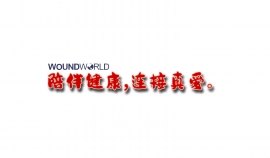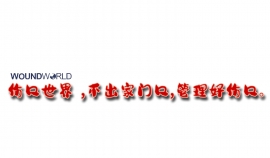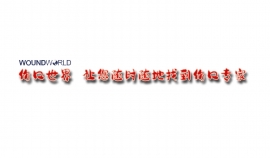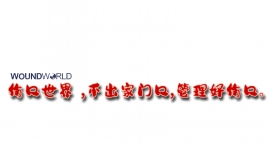
伤口世界

- 星期三, 03 4月 2024
Managing wounds at risk of infection in difficult-to-dress areas
Steven Percival
BSc, PGCE, MSc, MSc, PhD, CEO, 5D Health Protection Group Ltd, Professor (hon), School of Medicine, University of Manchester, UK
Leanne Atkin
PhD MHSc, RGN, Vascular Nurse Consultant/Lecturer Practitioner, Mid Yorks NHS Trust, University of Huddersfield, UK
Key words
- Infection
- Flaminal®
- Antimicrobial resistance
- Meeting report
Declarations
The symposium and report were supported by Flen Health.

- 星期二, 02 4月 2024
Evaluation of a technology lipido-colloid non-adherent dressing with silver in the management of burn patients — a case series from India
Management, as well as prevention, of wound infection is key in the promotion of the healing process. In India, over one million people are moderately or severely burnt every year, and managing the challenging burn wounds is a daily reality for clinicians in the country. Silver has been used as an antimicrobial in burn wound management for decades and modern advanced dressings can provide safe prevention and management of infection in these cases. This article reports the cases of two adults, an infant and a child with burns, at risk of infection and managed with a Technology Lipido-Colloid non-adherent dressing with silver (TLC-Ag; UrgoTul Ag/Silver). The main benefits observed when using the evaluated dressing in these patients included rapid wound healing but also patient-related outcomes, such as decrease in pain and atraumatic removal.
Clockwise from top left:
Dr Venkateswaran
Plastic Surgeon, Jupiter Hospital, Mumbai, India
Dr Ravichander Rao A
Plastic Surgeon, Care Hospital, Hyderabad, India
Dr Krishna Kumar
Plastic, Aesthetics, Burns, Hand and Reconstructive Microsurgeon, Kovai Medical Centre & Hospital, Coimbatore, India
Dr Sankamithra
Consultant Plastic Surgeon, Lakshmi Medical center, Pollachi, India
Key words
- Burns
- Lipido-colloid non-adherent dressing
- Silver
Declarations
All authors have no particular conflicts of interest to declare regarding these cases.

- 星期一, 01 4月 2024
Negative pressure wound therapy with vancomycin wound instillation: a case report
Negative pressure wound therapy (NPWT) supports the healing process by removing fluid and drawing out the infection from a wound, promoting the growth of new tissue. The device works by providing and distributing negative pressure evenly across the wound bed, either through the application of an open cell foam or a gauze dressing. NPWT provides a warm, moist wound bed while removing wound fluid that contains factors that inhibit cell growth, enhances wound oxygenation and improves the flow of blood and nutrients to the wound. NPWT also creates mechanical forces that influence the wound macroscopically, inducing cell proliferation, cell migration to the wound and angiogenesis. For infected wounds, the device can be used to instil antibiotics. In this article, a 57-year-old Caucasian woman with respiratory failure developed sepsis secondary to an intra-abdominal infection with abscess. Vancomycin 1mg/mL wound instillation, instilled as 100mL every 3 hours with a dwell time of 10 minutes, was administered concomitantly with intravenous vancomycin in the successful management of this patient.
Alison Bunnell
Doctor of Pharmacy Candidate 2022, North Dakota State University, Fargo, ND, USA
Erin Beauclair
Doctor of Pharmacy Candidate 2022, North Dakota State University, Fargo, ND, USA
Breanna Jones
Doctor of Pharmacy, Pharmacy Department, Sanford Medical Center Fargo, Fargo, ND, USA
Emily Greenstein
Advanced Practice Registered Nurse and Certified Nurse Practitioner, Wound Care, Sanford Medical Center Fargo, Fargo, ND, USA
Justin M Jones
Doctor of Pharmacy, Pharmacy Department, Sanford Medical Center Fargo, Fargo, ND, USA
Andrea R Clarens
Doctor of Pharmacy Pharmacy Department, Sanford Bemidji Medical Center, Bemidji, MN, USA
Key words
- Acute kidney injury
- Computed tomography
- Kidney Disease Improving Global Outcomes
- Negative pressure wound therapy
Declaration
Emily Greenstein reports she has been a consultant for Urgo medical, 3M and coloplast. 3M manufactures V.A.C. VeraFlo. None of these manufacture or distribute vancomycin instillation described in this manuscript.

- 星期五, 29 3月 2024
Do peripheral arterial disease and smoking impede diabetic ulcer healing?
Background: In some patients, diabetic foot ulcers may heal slowly despite tight control of blood glucose and normal limb circulation, implying the presence of multifactorial, unidentified factors to wound healing. Previous efforts to identify these factors using binary variables, such as amputation or specific healing timelines, inadequately reflect the complexities of wound healing capacity.
Aims: We aimed to identify factors associated with delayed diabetic foot ulcer healing.
Methods: Eight factors were assumed to affect diabetic foot ulcer healing; patient age, age at the onset of diabetes, sex, peripheral arterial disease (PAD), HbA1c, smoking as measured by the Brinkman index (BI), dialysis and bone infection. They were analysed using linear regression and multivariable analysis against three healing indices: total healing period (THP), granulation time (GT) and time to contraction onset (TCO).
Results: PAD and BI correlated positively with all three indices. Patients with PAD exhibited significantly extended THP, GT and TCO. An increase of 100 in BI corresponded with a 1.53 day increase in GT.
Conclusion: PAD was associated with delayed healing according to every measure analysed, while BI was linked with slower granulation. Besides THP, the measurements of GT — and possibly TCO — could evaluate some aspects of healing capacity of diabetic ulcers.
Kazufumi Tachi
Senior Lecturer, Division of Plastic Surgery, Tohoku Medical and Pharmaceutical University, Sendai, Japan
Koichi Gonda
Professor, Division of Plastic Surgery, Tohoku Medical and Pharmaceutical University, Sendai, Japan
Takashi Kochi
Chief Surgeon, Department of Plastic Surgery, Sendai City Hospital, Sendai, Japan
Jyunya Niwa
Research Associate, Division of Plastic Surgery, Tohoku Medical and Pharmaceutical University, Sendai, Japan
Key words
● Diabetic foot ulcer
● New index of wound healing
● Brinkman index
Declarations
All authors have no conflicts of interest to declare.
- 星期四, 28 3月 2024
Implementation of skin tone assessment in pressure ulcer prevention
Accurate skin assessment is key to pressure ulcer prevention. It has been shown that a lack of accurate assessment means that patients with dark skin tones are more likely to be diagnosed with higher-category pressure ulcers, leading to poorer outcomes (Oozageer Gunowa et al, 2017). This article highlights training and development carried out at the Christie NHS Foundation Trust in Manchester to incorporate skin tone awareness into aSSKINg bundle assessments and PURPOSE T pressure ulcer risk assessments, using the skin tone tool (Dhoonmoon et al, 2021).
Susy Pramod
Lead Tissue Viability Nurse, The Christie NHS Foundation Trust, Manchester
Jane Mayes
Honorary Tissue Viability Nurse, The Christie NHS Foundation Trust, Manchester; Clinical Education Manager, Essity
Katie Bowling
Tissue Viability Nurse, The Christie NHS Foundation Trust, Manchester
Ged McDermott
Tissue Viability Nurse, The Christie NHS Foundation Trust, Manchester
Key words
- Assessment
- Pressure ulcer
- PURPOSE T
- Skin tone

- 星期三, 27 3月 2024
Physical activity – how much is needed to optimise glycaemic control?
This systematic review and meta-analysis of 126 randomised controlled trials, published in Diabetes Care, identified that the weekly dose of physical activity required to optimise glucose-lowering in people with type 2 diabetes is 1100 Metabolic Equivalents of Task (MET)-minutes per week, and this remained consistent across a wide range of baseline HbA1c values.This is the equivalent of 36 minutes per day of moderate-paced walking, 244 minutes of moderate-intensity aerobic activity per week or 318 minutes of moderate strength training per week. Multicomponent activity (a mix of strength and aerobic activity), strength training and brisk walking were the most effective activities. Achieving the optimal weekly MET dose had greater effects in those with higher HbA1c at baseline, including up to a 1.02% reduction in those with an initial HbA1c >64 mmol/mol, and there was even a statistically significant 0.24–0.38% HbA1c reduction in those with prediabetes (HbA1c <48 mmol/mol) at baseline. These findings suggest that people with diabetes may need more physical activity than in the current generic recommendations of 150–300 minutes per week of moderate-intensity activity or 75–150 minutes per week of vigorous activity. Since we know that many do not achieve current recommendations consistently, helping people undertake these doses of physical activity is likely to need support from a multidisciplinary team, including exercise professionals and coaches, as well as from family and friends.
Pam Brown
GP in Swansea
Citation: Brown P (2024) Diabetes Distilled: Physical activity – how much is needed to optimise glycaemic control?
Diabetes & Primary Care 26: 241–3
